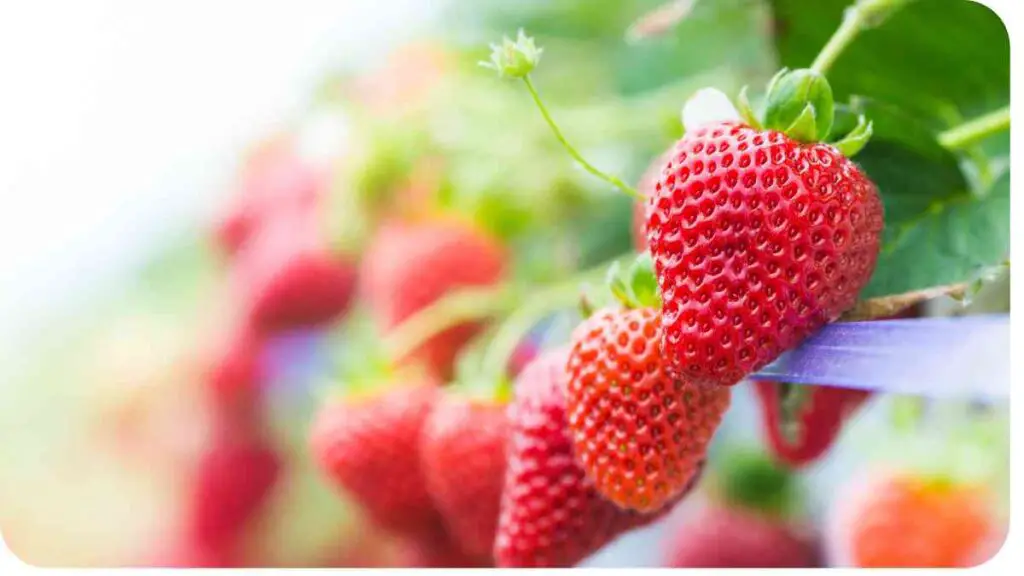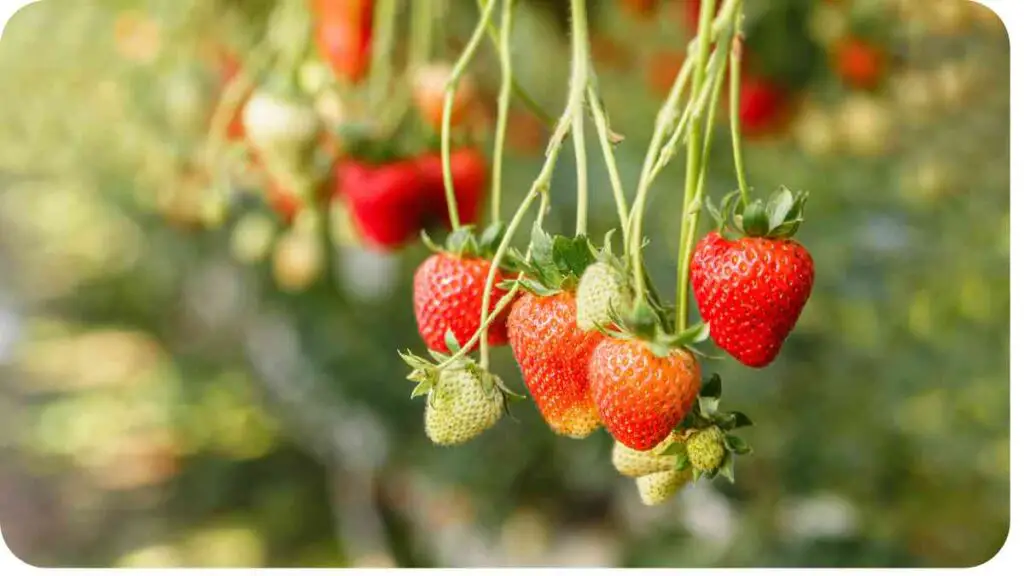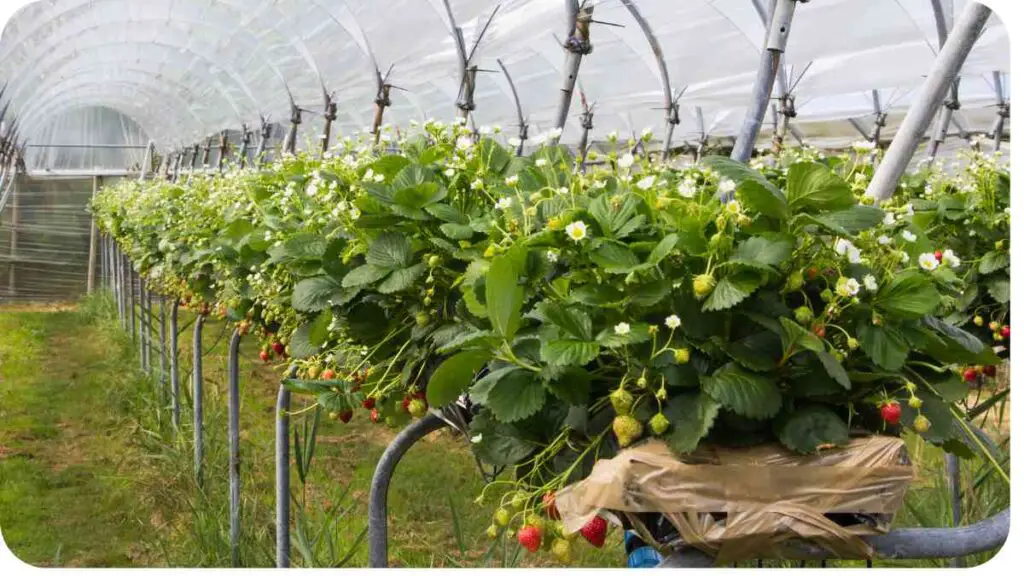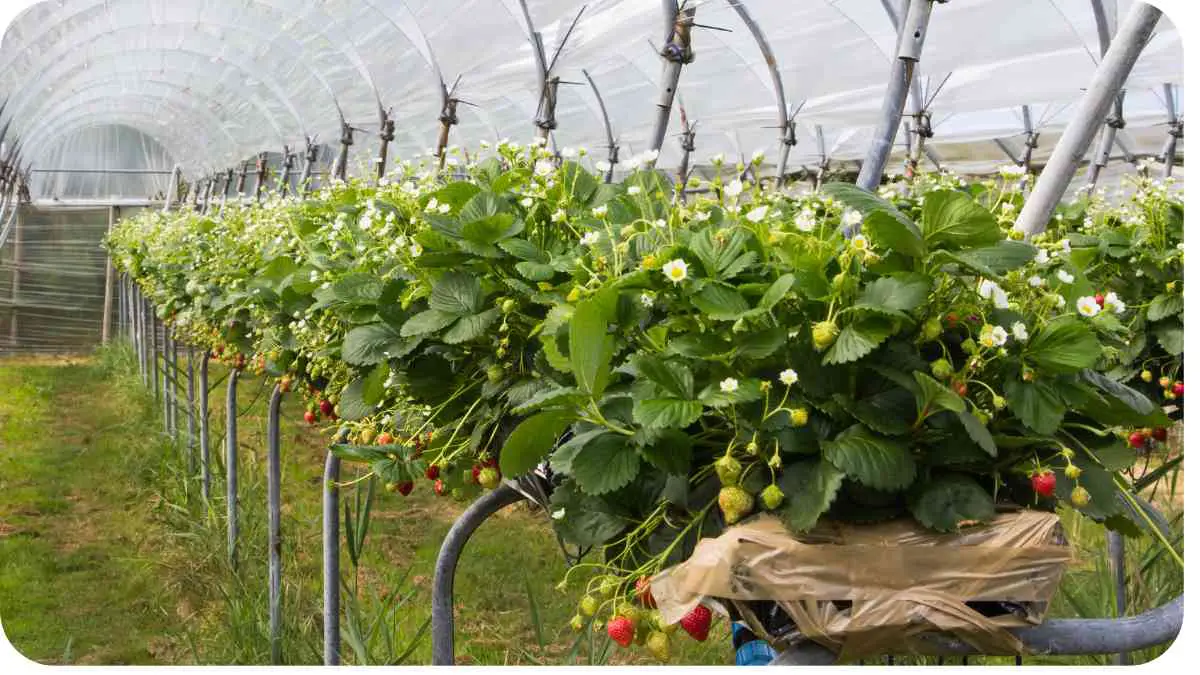Discover the secrets to cultivating mouthwatering hydroponic strawberries! Dive into our comprehensive guide to learn how to optimize sweetness, flavor, and yield in your hydroponic strawberry garden.
From nutrient balance to water management, we’ve got you covered with expert tips and insights. Get ready to indulge in the unparalleled taste of homegrown hydroponic strawberries.
| Key Takeaways |
|---|
| Hydroponic strawberries can be just as sweet and flavorful as soil-grown strawberries. |
| Hydroponic gardening offers many benefits, including faster growth rates, higher yields, and reduced water usage. |
| The use of water additives in hydroponic gardening can improve the taste and quality of hydroponic strawberries. |
| Hydroponic strawberries are safe to eat when grown using safe and sustainable methods. |
| Growing hydroponic strawberries requires proper nutrient balance and growing conditions. |
Are Hydroponic Strawberries Sweet?

Hydroponic strawberries have the potential to match or even surpass the sweetness of soil-grown strawberries. While traditionally soil-grown strawberries may start with a slight advantage in sugar content, hydroponic strawberries can catch up due to their unique growth conditions.
In hydroponic systems, strawberries grow faster and more efficiently utilize energy, resulting in concentrated sugars and enhanced flavor profiles. This accelerated growth, coupled with precise nutrient management, allows hydroponic strawberries to develop exceptional sweetness, often rivaling or exceeding that of soil-grown counterparts. T
herefore, while soil strawberries may initially have a higher sugar content, hydroponic strawberries can achieve comparable levels and offer deliciously sweet fruits.
“While both hydroponic and soil-based gardening have their advantages and disadvantages, hydroponics has the potential to revolutionize the way we grow our food. Learn more about the differences between the two in our guide on hydroponics vs soil gardening and decide which one suits your needs better.
Are Hydroponic Strawberries Safe To Eat?
Hydroponically grown strawberries are indeed safe to eat and offer numerous nutritional benefits. They serve as a rich source of vitamin C, boasting low calorie and fat content while providing essential carbohydrates and fiber.
Unlike conventional strawberries cultivated with chemical fertilizers, hydroponic strawberries have minimal sodium content, promoting healthier dietary choices. Additionally, hydroponic strawberries are free from pollen-related allergens, making them suitable for individuals with pollen allergies.
While both hydroponically and conventionally grown strawberries offer comparable levels of vitamin C, their antioxidant properties remain valuable additions to a balanced diet. Therefore, consuming hydroponically grown strawberries from reputable sources ensures both safety and nutritional value.
Hydroponic Strawberry Growing Checklist
| Task | Description |
|---|---|
| Choose a hydroponic system | Select a hydroponic system that suits your needs and budget. |
| Choose strawberry varieties | Choose strawberry varieties that are suitable for hydroponic growing and provide high yields. |
| Prepare the growing medium | Prepare the growing medium by sterilizing it and adding nutrients. |
| Plant the strawberries | Plant the strawberries in the growing medium and ensure that they receive the right amount of light and water. |
| Maintain the nutrient balance | Maintain the nutrient balance of the water by regularly checking the pH levels and adding nutrients as needed. |
| Control pests and diseases | Prevent pests and diseases by regularly inspecting the plants and using natural pest control methods. |
| Harvest the strawberries | Harvest the strawberries when they are fully ripe and enjoy the sweet and juicy taste of hydroponic strawberries. |
Do You Use Soil When Growing Strawberries Hydroponically?
No, soil is not used when growing strawberries hydroponically. Instead, a variety of inert growing mediums are employed to support the plants’ roots and provide stability.
These mediums include materials such as Rockwool, coco coir, perlite, vermiculite, and peat moss. Additionally, some growers incorporate compost or worm castings into the medium to enhance nutrient availability.
Each of these materials differs in nutrient composition, water retention capabilities, and particle size, allowing growers to tailor their choice to specific plant requirements and environmental conditions. For beginners in hydroponic gardening, experimenting with different mediums is recommended to determine the most suitable option for successful strawberry cultivation.
If you’re considering growing hydroponic vegetables, you may be wondering whether they are as healthy as their soil-grown counterparts. Our article on the health benefits of hydroponic vegetables explores this question in detail and provides insights into the nutritional content of hydroponically grown vegetables.
How Much Water Do Hydroponic Strawberries Use?

Hydroponic strawberries indeed use less water compared to soil-based and traditional farming methods. This efficiency stems from several factors inherent to hydroponic cultivation.
Firstly, in hydroponic systems, plants do not need to extract water from the soil, eliminating evaporation and runoff typically associated with soil farming. Additionally, the absence of direct sunlight exposure to the roots reduces the plants’ moisture absorption from their surroundings, further minimizing water usage.
Moreover, hydroponic farmers can precisely regulate irrigation levels, ensuring that each plant receives the optimal amount of liquid directly to its root system. This targeted approach to watering maximizes water efficiency, requiring fewer resources overall.
However, while hydroponics offers water-saving advantages, aspiring hydroponic strawberry growers should be aware that achieving complete self-sufficiency and significant cost savings may not be straightforward.
Despite its efficiency in resource utilization, hydroponic systems still entail ongoing maintenance costs, such as electricity for pumps and lighting systems, as well as periodic replacements of worn-out equipment. Therefore, while hydroponics presents a more efficient alternative to traditional farming in terms of water usage, careful consideration of associated maintenance costs is crucial for long-term success and sustainability.
Recommended Nutrients for Hydroponic Strawberries
| Nutrient | Role | Recommended Amount |
|---|---|---|
| Nitrogen | Promotes leaf growth and overall plant development. | 100 ppm |
| Phosphorus | Helps with root growth and flower development. | 50 ppm |
| Potassium | Helps with overall plant development and improves fruit quality. | 150 ppm |
| Calcium | Helps with cell wall development and overall plant health. | 150 ppm |
| Magnesium | Essential for photosynthesis and helps with fruit quality. | 50 ppm |
Is Hydroponics Better Than Soil?
Hydroponics presents several advantages over traditional soil-based cultivation methods, particularly when it comes to growing strawberries.
One significant benefit of hydroponics is its space efficiency. Hydroponic systems allow growers to cultivate strawberries in smaller areas, making it an ideal option for those with limited space. Additionally, the reduced need for soil eliminates the laborious task of soil preparation and nutrient supplementation required in traditional soil farming.
Furthermore, hydroponic strawberries do not rely on expansive root systems to search for nutrients in the soil. Instead, their roots are directly submerged in a nutrient-rich water solution, ensuring efficient nutrient uptake without the need for extensive root spread. This streamlined nutrient delivery system not only saves space but also minimizes water consumption, as hydroponic plants absorb nutrients directly from the water.
Moreover, growing strawberries hydroponically indoors offers flexibility in terms of lighting requirements. Unlike outdoor cultivation, indoor hydroponic systems can be supplemented with artificial lighting, reducing reliance on natural sunlight and potentially lowering costs.
In summary, hydroponic cultivation of strawberries offers advantages such as space efficiency, reduced maintenance, and optimized nutrient delivery, making it a compelling alternative to traditional soil-based methods.
Tomatoes are a popular choice for hydroponic growers, but are they any good? In our guide on the benefits of hydroponic tomatoes, we explain why hydroponic tomatoes may be a better option than soil-grown tomatoes and discuss their taste, texture, and nutritional value.
Can You Grow Strawberries Indoors?
Absolutely, strawberries can be successfully grown indoors with proper care and attention to their light and space requirements.
Indoor cultivation of strawberries necessitates ample sunlight, so positioning them near a well-lit window is essential. If natural sunlight is insufficient, supplemental artificial lighting can be used to ensure adequate light exposure for the plants.
When growing strawberries indoors, it’s crucial to provide them with containers that offer good drainage to prevent waterlogging and root rot. Planting strawberries in pots or planters allows for flexibility in placement and ensures optimal root growth.
To maximize the chances of success, ensure that indoor-grown strawberries have enough space for root development and are not overcrowded. Planting them at least 4 inches apart in containers provides sufficient room for growth and prevents competition for nutrients and space.
How Often Do You Water Strawberries In A Hydroponic System?
In a hydroponic environment, strawberries need to be watered daily. The amount of water you use depends on the size of your strawberry plants.
If you are growing them in large containers or buckets, you can apply about five gallons per plant per day. Smaller pots require less water and should only receive two to three gallons every 24 hours.
If you do not have access to an irrigation system for your hydroponic strawberries (or if it’s too complicated for you).
Then using a mister is one way to ensure that they get enough moisture without over-watering them and causing root rot or mold issues. Using this method will also help keep humidity levels up so that mold doesn’t grow on your fruit!
How Long Does It Take For Strawberries To Grow Hydroponically?

The time it takes for hydroponically grown strawberries to mature and become ready for harvest typically ranges from 6 to 8 weeks. However, the specific duration may vary depending on the strawberry variety being cultivated.
Compared to soil-grown strawberries, which can take up to 3 months to reach harvest readiness, hydroponic strawberries offer a faster growth cycle, allowing for quicker turnaround times and more frequent harvests.
A key indicator that hydroponic strawberries are ready for harvest is when their roots have fully extended to the bottom of their pots, indicating that they have absorbed all available nutrients. At this stage, the plants may cease further growth until provided with additional nutrient sources.
Are hydroponic strawberries as healthy as traditional strawberries? Our article on the health benefits of hydroponic strawberries delves into the nutritional content of hydroponic strawberries and explains why they can be a great addition to your diet. Check it out to learn more.
What Do I Need To Grow My Own Hydroponic Garden?
To set up your own hydroponic garden for growing strawberries, you’ll need the following essentials:
- Hydroponic System: Choose a hydroponic system that suits your space, budget, and growing goals. Options include passive systems like wick or Kratky, or active systems such as nutrient film technique (NFT) or deep water culture (DWC). Research each type to determine the best fit for your needs.
- Substrate: Select a substrate to support the roots of your strawberry plants. Common choices include Rockwool, coco coir, perlite, vermiculite, or peat moss. The substrate should provide stability for the roots and allow for efficient nutrient absorption.
- Nutrient Solution: Prepare a nutrient solution or nutrient salts mixed with water to provide essential nutrients for your plants. Ensure the solution is well-balanced and contains all necessary macro and micronutrients for healthy growth. Regularly monitor and adjust the nutrient levels to maintain optimal plant health.
- pH and EC Meter: Invest in a pH and electrical conductivity (EC) meter to monitor the acidity and nutrient concentration of your hydroponic solution. Keeping these levels within the optimal range is crucial for plant growth and nutrient uptake.
- Grow Lights: If growing indoors or in a location with insufficient natural sunlight, you’ll need grow lights to provide adequate light for your strawberry plants. LED or fluorescent grow lights are popular options for hydroponic setups.
- Containers or Growing Beds: Choose suitable containers or growing beds to hold your strawberry plants and hydroponic system components. Ensure containers have proper drainage to prevent waterlogging.
- Water Supply: Have a clean and reliable water supply available for preparing nutrient solutions and watering your plants. Use filtered or dechlorinated water to avoid harmful chemicals that could affect plant health.
- Timers and Pumps: If using an active hydroponic system, you’ll need timers and pumps to regulate nutrient solution delivery and ensure proper circulation within the system.
By gathering these essential components and setting up your hydroponic garden correctly, you can enjoy the satisfaction of growing delicious strawberries in a soil-free environment, free from soil impurities and conducive to optimal plant growth.
What Is The Best Fertilizer For Strawberries?
When selecting a fertilizer for strawberries, it’s essential to choose one that provides the necessary nutrients for healthy growth and fruit production. Here are some options to consider:
- Fish Emulsion: Fish emulsion is a liquid fertilizer made from fish, seaweed, and water. It is rich in nitrogen, phosphorus, and potassium, as well as micronutrients. Fish emulsion is easily absorbed by the roots of plants and is an excellent choice for promoting vigorous growth and fruit development in strawberries.
- Compost: Compost is a natural fertilizer that contains a balanced mix of nitrogen, phosphorus, and potassium, along with organic matter and beneficial microorganisms. Incorporating compost into the soil or growing medium enriches it with essential nutrients and improves soil structure, promoting healthy root growth and abundant fruiting in strawberries.
- Worm Castings: Worm castings, also known as vermicompost, are the nutrient-rich excrement produced by earthworms as they digest organic matter. Worm castings contain high levels of nitrogen, phosphorus, potassium, and beneficial microorganisms, making them an excellent fertilizer for strawberries. They improve soil fertility, enhance nutrient uptake, and support overall plant health.
- Liquid Fertilizers: Liquid fertilizers formulated specifically for strawberries provide a convenient and efficient way to deliver essential nutrients to plants. These fertilizers contain balanced ratios of nitrogen, phosphorus, and potassium, along with micronutrients such as calcium, magnesium, iron, and zinc. Liquid fertilizers can be applied directly to the soil or hydroponic solution, ensuring rapid absorption and uptake by strawberry plants.
- Organic Amendments: Organic amendments such as bone meal, blood meal, and kelp meal are natural sources of phosphorus, nitrogen, and potassium, respectively. These amendments can be incorporated into the soil or growing medium to provide a slow-release source of nutrients for strawberries over time.
Hydroponics Is An Interesting Way To Grow Plants
Hydroponics offers an innovative approach to plant cultivation, bypassing the need for traditional soil-based methods. Instead, plants are grown with their roots suspended in nutrient-rich water solutions.
One of the key advantages of hydroponics is its ability to support plants with smaller root systems. Unlike in soil, where roots must spread out extensively to seek nutrients, hydroponic plants can access nutrients directly from the water surrounding their roots. This streamlined process allows for more efficient nutrient absorption and promotes healthier, more vigorous growth.
While some hydroponic systems utilize growing mediums like coco coir or clay pellets to support plant roots above the water level, others rely solely on gravity for structural support. Regardless of the specific setup, hydroponics offers a versatile and adaptable method for cultivating a wide range of plants, providing ample opportunities for experimentation and innovation in indoor and outdoor gardening practices.
Ensuring that your hydroponic plants receive the right nutrients is essential to their growth and development, but are hydroponic nutrients safe? Our guide on the safety of hydroponic nutrients explains the risks associated with certain types of hydroponic nutrients and offers tips on how to ensure the safety of your plants and yourself.
Conclusion
In conclusion, hydroponics offers an intriguing method for growing strawberries and various other plants. Whether you’re a seasoned gardener or a novice enthusiast, hydroponic cultivation presents an exciting opportunity to explore innovative growing techniques.
To embark on your hydroponic strawberry-growing journey, start by acquiring plants and supplies from your local nursery or hardware store. With the right equipment and guidance, setting up your hydroponic system can be a rewarding and fulfilling experience.
Follow our instructions and guidance to establish your hydroponic setup successfully. With dedication and attention to detail, you can enjoy the satisfaction of cultivating delicious strawberries in a soil-free environment, all within the comfort of your own home. Happy gardening!
Further Reading
Here are some additional resources that can help you learn more about hydroponic gardening and growing strawberries:
How to Grow Hydroponic Strawberries for a Sweet Juicy Treat: This comprehensive guide explains how to grow hydroponic strawberries step by step and provides tips on how to ensure a bountiful harvest.
Hydroponic Water Additives Enhance Flavor: This article discusses the use of water additives in hydroponic gardening to improve the taste and quality of hydroponic strawberries.
Effects of Different Growing Conditions on the Quality of Hydroponic Strawberry: This scientific research paper examines the effects of different growing conditions on the quality of hydroponic strawberries and provides insights into the best practices for growing high-quality hydroponic strawberries.
FAQs
What is hydroponic gardening?
Hydroponic gardening is a method of growing plants without soil, using nutrient-rich water instead. This method is gaining popularity due to its many benefits, including faster growth rates, higher yields, and reduced water usage.
Can hydroponic strawberries be as sweet as soil-grown strawberries?
Yes, hydroponic strawberries can be just as sweet and flavorful as soil-grown strawberries, provided that they receive the right nutrients and growing conditions. In fact, some growers report that hydroponic strawberries are even sweeter than soil-grown strawberries.
What are some common additives used in hydroponic gardening?
Some common additives used in hydroponic gardening include pH adjusters, nutrients, and water treatments. These additives are used to ensure that the plants receive the right balance of nutrients and to maintain the pH balance of the water.
Are hydroponic strawberries safe to eat?
Yes, hydroponic strawberries are safe to eat, provided that they are grown using safe and sustainable methods. Hydroponic gardening is generally considered to be safer than traditional soil gardening, as it reduces the risk of soil-borne diseases and eliminates the need for harmful pesticides.
How long does it take to grow hydroponic strawberries?
The time it takes to grow hydroponic strawberries can vary depending on the variety of strawberry and the growing conditions. Generally, it takes about 3-4 months for hydroponic strawberries to reach maturity and produce fruit.

For 15 years, Hellen James has worked in the gardening industry as an expert and landscape designer. During her career, she has worked for a variety of businesses that specialize in landscaping and gardening from small firms to large corporations.

